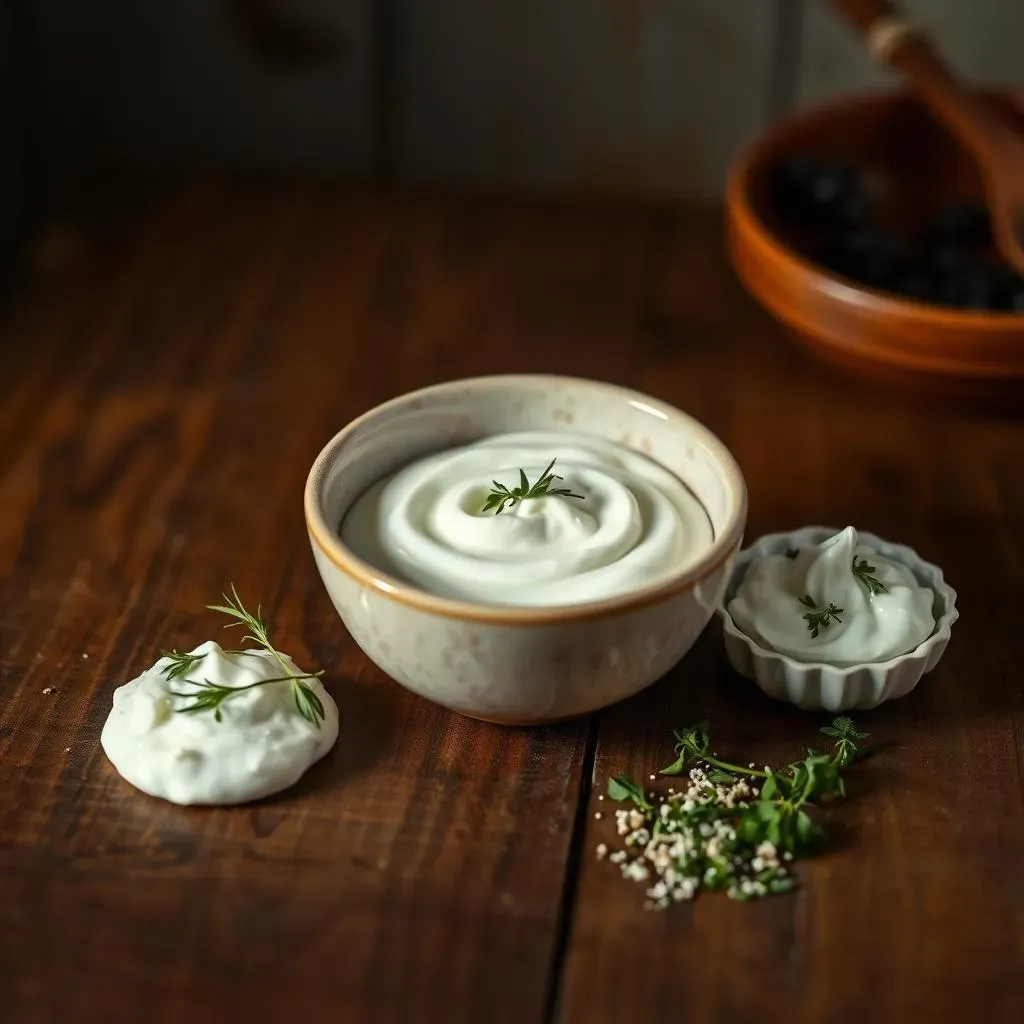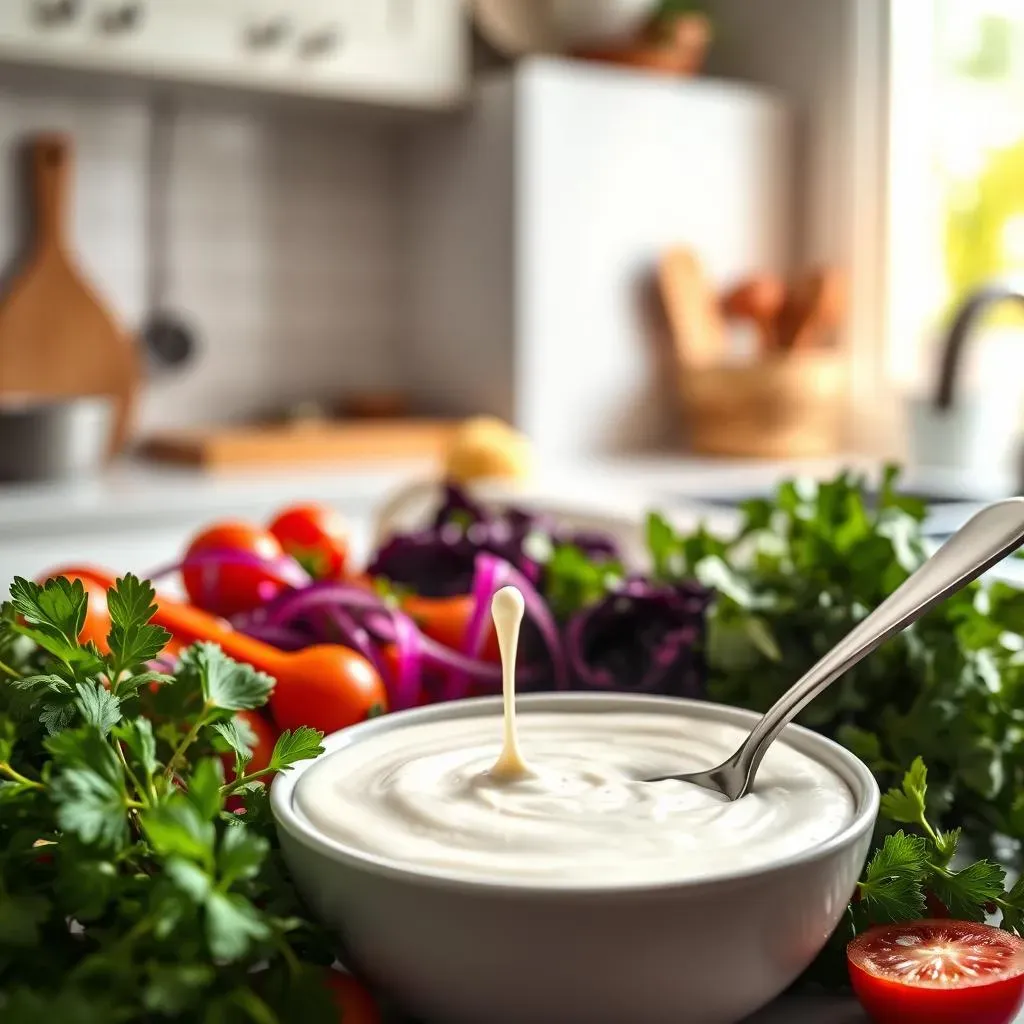Table of Contents
Ever found yourself mid-recipe, staring into the fridge, only to realize you're out of sour cream? It's a common kitchen calamity. But don't panic! There's a hero in disguise, often lurking right next to the milk: plain yogurt. The idea of substituting plain yogurt for sour cream might seem odd at first, but trust me, it's a game-changer. This article is your guide to mastering this simple swap. We’ll explore why this substitution works, how to do it right in different recipes, and what to watch out for. Think of it as your personal cheat sheet for all things yogurt and sour cream. From dips to baked goods, we'll cover it all, ensuring your culinary creations are never compromised by a missing ingredient. Let's get started and unlock the secrets to seamless substitutions. You might just find you prefer the yogurt version!
Why Substitute? The Lowdown on Yogurt and Sour Cream

Why Substitute? The Lowdown on Yogurt and Sour Cream
The Great Dairy Dilemma
let's be real, sometimes you just run out of stuff. Sour cream, with its tangy richness, is a staple in many recipes, but what happens when your tub is empty? That's where plain yogurt enters the picture. It’s not just a random substitute; it’s a surprisingly good one, often healthier too! Both are made from dairy, but they differ in fat content and how they’re made. Sour cream gets its tang from lactic acid cultures, just like yogurt, but it has a higher fat content that gives it that thick, creamy texture. Plain yogurt, on the other hand, can range in fat levels from non-fat to full-fat, meaning you have some control over the end result.
The best part about using yogurt as a substitute is the fact that you're usually getting more protein and less fat. This is a win-win for people who are looking for healthier ways to cook. I remember one time, I was making tacos and realized I was completely out of sour cream. That's when I decided to try using plain yogurt as a substitute. I was shocked that it tasted great, and I've been doing it ever since! It's like a secret weapon in the kitchen, a simple swap that can make a big difference.
Texture and Tang: The Key Differences
The real magic of substituting plain yogurt for sour cream lies in understanding their differences in texture and tang. Sour cream is known for its thick, almost decadent feel, which makes it perfect for dolloping on tacos or stirring into sauces. Plain yogurt, on the other hand, can vary quite a bit in thickness. Greek yogurt, for example, is much thicker than regular yogurt due to the way it's strained, making it an excellent match for sour cream. The tanginess is also key, both have a slightly sour taste due to lactic acid, but sour cream often has a more pronounced, richer flavor. When substituting, you might need to add a touch of lemon juice or vinegar to plain yogurt to really replicate that sour cream zing. It's all about tweaking and tasting as you go to get the result you want.
I've learned that the key to a successful substitution is to pay attention to the fat content of the yogurt. If you’re swapping it in something like a creamy soup, full-fat yogurt does a better job at mimicking sour cream’s richness. I even use it in my mashed potatoes sometimes, and no one ever notices the difference! It's these small details that can make or break your dish.
Feature | Sour Cream | Plain Yogurt |
|---|---|---|
Fat Content | High | Variable (Low to Full) |
Texture | Thick, Creamy | Variable (Thin to Thick) |
Tanginess | Pronounced | Mild to Medium |
Protein | Lower | Higher |
Use Cases | Dips, Toppings, Baking | Dips, Toppings, Baking, Smoothies |
Substituting Plain Yogurt for Sour Cream: A RecipebyRecipe Guide

Substituting Plain Yogurt for Sour Cream: A RecipebyRecipe Guide
Dips and Dressings: A Smooth Transition
When it comes to dips and dressings, substituting plain yogurt for sour cream is a breeze. The key is to start with a thick yogurt, like Greek yogurt, since it mimics the creamy consistency of sour cream. For a classic ranch dip, I just swap in the same amount of plain Greek yogurt, and it works perfectly. If the yogurt is a bit too thick, you can thin it out with a splash of milk or water until you get the desired consistency. I also like to add a squeeze of lemon juice or a dash of vinegar to bring out that extra tang that sour cream usually has. It's all about adjusting to your taste buds, which makes cooking even more fun.
I've found that in dressings, yogurt not only makes it lighter but also adds a unique flavor that sour cream sometimes lacks. I once made a Caesar dressing using yogurt, and it was a hit! Everyone loved it and couldn’t tell the difference. The trick is to balance the flavors, so you might need a little more garlic or herbs to make up for the difference in richness. The best part is that you can experiment and come up with your own unique twist! It's all about making your food your own.
Baking: A Delicate Balance
Baking with yogurt instead of sour cream is where things get a bit more interesting. The general rule of thumb is still a 1:1 swap, but the moisture content can play a big role here. If you're making something like a cake or muffins, using full-fat yogurt is usually best because it has a higher fat content, which is closer to sour cream. This helps keep your baked goods moist and tender. If you use low-fat yogurt, you might need to add a bit more liquid to the recipe to compensate. I’ve learned this the hard way by baking a batch of dry muffins! The lesson? Pay attention to the fat content!
In recipes like banana bread or quick breads, yogurt can be a real game-changer. It adds a lovely tang and makes the bread incredibly moist. I like to use Greek yogurt here because it’s so thick. The key is to mix it in gently and to not overmix the batter. Overmixing can make your baked goods tough, and nobody wants that! I remember one time when I made a yogurt-based banana bread, and everyone thought it was the best one I’d ever made. It’s amazing how a simple substitution can make such a big difference.
Recipe Type | Yogurt Type | Tips |
|---|---|---|
Dips | Greek Yogurt | Add lemon juice for tang |
Dressings | Plain or Greek Yogurt | Adjust seasonings to taste |
Cakes | Full-Fat Yogurt | Monitor moisture levels |
Quick Breads | Greek Yogurt | Mix gently |
Toppings and Garnishes: The Finishing Touch
When it comes to using yogurt as a topping or garnish, the possibilities are endless. It can add a cool and creamy touch to spicy dishes or a refreshing element to soups. I love using plain yogurt on my tacos and chili – it works just as well as sour cream. The trick is to make sure the yogurt is cold, as this will give you that nice, cooling effect. I also sometimes add a bit of salt and pepper to the yogurt to enhance its flavor. A dollop of yogurt can make a simple dish look fancy, and it's so easy to do. It’s like the cherry on top, but way healthier.
I often use yogurt as a garnish on soups, especially chilled ones. It adds a creamy texture and a lovely tang that balances out the flavors. I recently made a chilled cucumber soup and used yogurt as a garnish, and it was delicious. The key is to not overdo it; a little goes a long way. I sometimes mix in some chopped herbs for an extra pop of flavor and color. It's all about creating a visual and flavorful experience with minimal effort. It's amazing how a simple substitution can make such a big impact.
Troubleshooting and Tips for Perfect Substitutions

Troubleshooting and Tips for Perfect Substitutions
Dealing with Runny Yogurt
so sometimes your yogurt might be a bit too watery, and that's totally normal. It's just the whey separating, which is the liquid part of yogurt. But don't fret! There are easy ways to fix it. One simple trick is to strain the yogurt. Just line a sieve with cheesecloth or a coffee filter, place it over a bowl, and pour the yogurt in. Let it sit for about 30 minutes, and the excess liquid will drain out. You'll be left with a thicker, creamier yogurt that's much closer to the consistency of sour cream. I’ve even used a paper towel in a pinch and it worked just fine! It's all about knowing your options and not being afraid to experiment.
Another thing to consider is the fat content. If you’re using non-fat yogurt, it’s naturally going to be thinner than full-fat yogurt. So, if you need that extra richness, opt for a higher fat content. Sometimes, I'll even add a spoonful of cornstarch or arrowroot powder to the yogurt to thicken it up, especially if I'm using it in a hot dish. Just make sure to mix it in well to avoid any clumps. It’s these little tweaks that can make a big difference in your recipe.
Issue | Solution |
|---|---|
Runny Yogurt | Strain using cheesecloth or coffee filter |
Thin Consistency | Use full-fat yogurt or add cornstarch |
Missing Tang | Add lemon juice or vinegar |
Adjusting for Taste
Now, let's talk about that tangy flavor. Sour cream has a distinct taste, and sometimes plain yogurt just doesn't quite cut it. But don't worry, you can easily adjust the flavor to get it just right. The easiest way to do this is to add a little acid, like a squeeze of lemon juice or a dash of white vinegar. Start with a small amount, taste, and then add more until you get the desired tang. I usually start with about half a teaspoon and go from there. It's all about finding that perfect balance. I’ve even used lime juice sometimes when I'm making Mexican-inspired dishes, and it works wonders. It's like a little flavor boost that takes your yogurt from bland to brilliant!
Another great way to adjust the flavor is to add a pinch of salt. Salt can enhance the tanginess and bring out the flavors in your dish. I sometimes add a bit of garlic powder or onion powder for extra depth, depending on what I'm making. The great thing about cooking is that you can tweak it to your liking. It’s like being a flavor artist, and your kitchen is your canvas. Just remember to taste as you go, and you’ll be a pro in no time.
When Not to Substitute
While substituting plain yogurt for sour cream is a fantastic trick, there are a few times when it might not be the best idea. If a recipe relies heavily on the richness and high fat content of sour cream, like a very decadent frosting or a super creamy sauce, yogurt might not give you the same results. In these cases, you might want to stick with sour cream or look for a more suitable alternative. I remember trying to make a super rich chocolate frosting with yogurt once, and it just wasn’t the same. The texture was off, and it lacked that full-bodied flavor. It’s these little kitchen mishaps that teach you the importance of knowing your ingredients and when to make the swap.
Also, if you're making something that requires a very stable and thick texture, like a baked cheesecake, yogurt might not hold up as well as sour cream. The higher fat content in sour cream helps to create that dense, creamy texture that is essential in some recipes. In these instances, it’s better to use sour cream or do a lot of research into how to adjust the recipe. It’s all about knowing the limits of what you can substitute. But don't let that discourage you; for most recipes, yogurt is a great and healthier swap. It's just about knowing when to use it and when to stick to the original plan.
Wrapping Up: Your Yogurt Substitution Success
So, there you have it. Substituting plain yogurt for sour cream isn't just a kitchen hack; it's a versatile technique that can lighten up your meals and save the day when you're short on ingredients. Whether you're aiming for a healthier option or simply need a quick swap, yogurt is a reliable stand-in. Remember the key points: use a 1:1 ratio for most recipes, consider the fat content for specific applications, and don't be afraid to experiment. With a little practice, you'll become a pro at this substitution, adding a tangy twist to your culinary adventures. Now, go forth and conquer your recipes, with yogurt as your secret weapon!